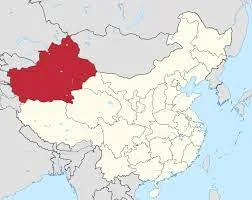Nationalist China's plan to relocate and colonize Uighur lands
Zhou Zongtang occupied the Uighur lands in 1878, and in 1884, with the establishment of a provincial system under the name "Xinjiang" which means "newly occupied land", the idea of relocating large numbers of Chinese people to the area began to emerge.
Sun Zhongshan, the founder of the People's Republic of China, also proposed a formal "colonization" of the Uighur lands in his "State-Building Program" prepared from 1917-1920, which included a plan to build a railway to "colonize" and relocate 10 million people. Taran Uyghur, a U.S. history researcher who translates Kuomintang archival documents into Uighur, believes that Sun Zhongshan's dream has always been sought by Kuomintang authorities led by the next Zhang Kaishi.
Under Chinese militarists such as Yang Zengxin, Jin Shuren, and Sheng Shisei, the idea of relocating large numbers of Chinese people to Uyghur lands continued, and although a number of Chinese migrated and settled on their own, direct relocation by the state did not take place.
From the point of view of the population structure of the Uyghur diaspora, the Uyghurs have always been the largest population in the land. The arrival of the Chinese in this area is due to the repeated occupations of the Manchu Empire in the 18th and 19th centuries. The Chinese population was mainly concentrated in areas such as the Kure in the Ili Valley, the administrative centers of Manchu and the Chinese militarists, and the area around Urumqi and Barikol. By the 1940s, the Chinese population was still small in the entire Uyghur diaspora, and according to a 1944 census by the Xinjiang Provincial Police Department of the Kuomintang, the Chinese made up 5.5% of the total population. The census was published by China in August 1947 in Shanghai's New Age magazine. According to the data, Uyghurs are the largest population, accounting for 76.5% of the total population. The total Muslim population is about 93.
According to some historical sources, in 1943, after the Chinese Kuomintang government occupied the Uighur lands, Sheng Shisei and Zhang Kaishi planned to relocate one million people to Xinjiang. In November 1944, He Jingwu, the head of the Northwest Highway and Transportation Bureau under the Chinese Central Government and later the Deputy Commander-in-Chief of the Chinese Army, prepared a special resettlement project and presented it to Zhang Kaishi. He Jingwu proposed to relocate 500,000 people to the Uyghur diaspora within seven years as part of a national plan to increase the Chinese population in the region. The confidential file is stored in the National History Museum in Taiwan, according to Taran Uighur, who translated the document into Uighur, according to the Chinese government. Even the time and location of the deployment are planned.
One of the highlights of the resettlement project is the land reclamation by the military, which will be used to evacuate 200,000 war wounded and wounded soldiers who have been healed and vacated, and to relocate them.
However, Chinese Kuomintang authorities have failed to implement the plan to relocate 500,000 people.
The reason for this was the liberation of all three provinces by the Republic of East Turkestan, which was established in November 1944, until October 1945, and the rise of resistance in the south and elsewhere.
Alimcan Inayet, a professor at Ege University in Turkey, believes that although there has been hope of relocating large numbers of Chinese people to East Turkestan since the Zoe Zongtang era, these have not materialized. China's own internal situation in the 1940s and the situation in East Turkestan did not allow for that.
But the Chinese central government has set up a railway to connect Lanzhou and Urumqi, relocating large numbers of people to the Uyghur diaspora, increasing the Chinese population in less populated areas, and even encouraging intellectuals, cadres, members of the Kuomintang party, and professionals to "go and work in Xinjiang." Issues of strengthening comprehensive governance were discussed, and some of them have been gradually implemented. According to Mr. Taran Uyghur, the Chinese government's resettlement plan was aimed at destabilizing and colonizing the Uyghur diaspora and not benefiting the local people.(rfa.org)


